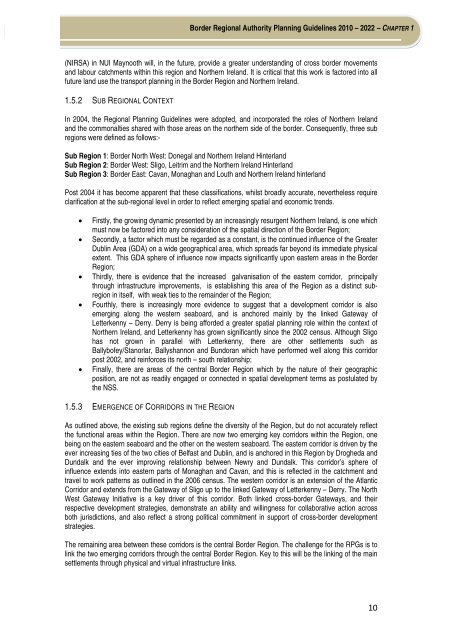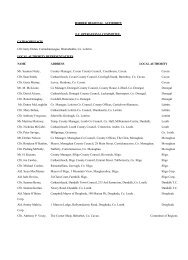downloads/RPGs/Border Regional Authority RPGs 2010-2022.pdf
downloads/RPGs/Border Regional Authority RPGs 2010-2022.pdf
downloads/RPGs/Border Regional Authority RPGs 2010-2022.pdf
Create successful ePaper yourself
Turn your PDF publications into a flip-book with our unique Google optimized e-Paper software.
<strong>Border</strong> <strong>Regional</strong> <strong>Authority</strong> Planning Guidelines <strong>2010</strong> – 2022 – CHAPTER 1<br />
(NIRSA) in NUI Maynooth will, in the future, provide a greater understanding of cross border movements<br />
and labour catchments within this region and Northern Ireland. It is critical that this work is factored into all<br />
future land use the transport planning in the <strong>Border</strong> Region and Northern Ireland.<br />
1.5.2 SUB REGIONAL CONTEXT<br />
In 2004, the <strong>Regional</strong> Planning Guidelines were adopted, and incorporated the roles of Northern Ireland<br />
and the commonalties shared with those areas on the northern side of the border. Consequently, three sub<br />
regions were defined as follows:-<br />
Sub Region 1: <strong>Border</strong> North West: Donegal and Northern Ireland Hinterland<br />
Sub Region 2: <strong>Border</strong> West: Sligo, Leitrim and the Northern Ireland Hinterland<br />
Sub Region 3: <strong>Border</strong> East: Cavan, Monaghan and Louth and Northern Ireland hinterland<br />
Post 2004 it has become apparent that these classifications, whilst broadly accurate, nevertheless require<br />
clarification at the sub-regional level in order to reflect emerging spatial and economic trends.<br />
• Firstly, the growing dynamic presented by an increasingly resurgent Northern Ireland, is one which<br />
must now be factored into any consideration of the spatial direction of the <strong>Border</strong> Region;<br />
• Secondly, a factor which must be regarded as a constant, is the continued influence of the Greater<br />
Dublin Area (GDA) on a wide geographical area, which spreads far beyond its immediate physical<br />
extent. This GDA sphere of influence now impacts significantly upon eastern areas in the <strong>Border</strong><br />
Region;<br />
• Thirdly, there is evidence that the increased galvanisation of the eastern corridor, principally<br />
through infrastructure improvements, is establishing this area of the Region as a distinct subregion<br />
in itself, with weak ties to the remainder of the Region;<br />
• Fourthly, there is increasingly more evidence to suggest that a development corridor is also<br />
emerging along the western seaboard, and is anchored mainly by the linked Gateway of<br />
Letterkenny – Derry. Derry is being afforded a greater spatial planning role within the context of<br />
Northern Ireland, and Letterkenny has grown significantly since the 2002 census. Although Sligo<br />
has not grown in parallel with Letterkenny, there are other settlements such as<br />
Ballybofey/Stanorlar, Ballyshannon and Bundoran which have performed well along this corridor<br />
post 2002, and reinforces its north – south relationship;<br />
• Finally, there are areas of the central <strong>Border</strong> Region which by the nature of their geographic<br />
position, are not as readily engaged or connected in spatial development terms as postulated by<br />
the NSS.<br />
1.5.3 EMERGENCE OF CORRIDORS IN THE REGION<br />
As outlined above, the existing sub regions define the diversity of the Region, but do not accurately reflect<br />
the functional areas within the Region. There are now two emerging key corridors within the Region, one<br />
being on the eastern seaboard and the other on the western seaboard. The eastern corridor is driven by the<br />
ever increasing ties of the two cities of Belfast and Dublin, and is anchored in this Region by Drogheda and<br />
Dundalk and the ever improving relationship between Newry and Dundalk. This corridor’s sphere of<br />
influence extends into eastern parts of Monaghan and Cavan, and this is reflected in the catchment and<br />
travel to work patterns as outlined in the 2006 census. The western corridor is an extension of the Atlantic<br />
Corridor and extends from the Gateway of Sligo up to the linked Gateway of Letterkenny – Derry. The North<br />
West Gateway Initiative is a key driver of this corridor. Both linked cross-border Gateways, and their<br />
respective development strategies, demonstrate an ability and willingness for collaborative action across<br />
both jurisdictions, and also reflect a strong political commitment in support of cross-border development<br />
strategies.<br />
The remaining area between these corridors is the central <strong>Border</strong> Region. The challenge for the <strong>RPGs</strong> is to<br />
link the two emerging corridors through the central <strong>Border</strong> Region. Key to this will be the linking of the main<br />
settlements through physical and virtual infrastructure links.<br />
10






